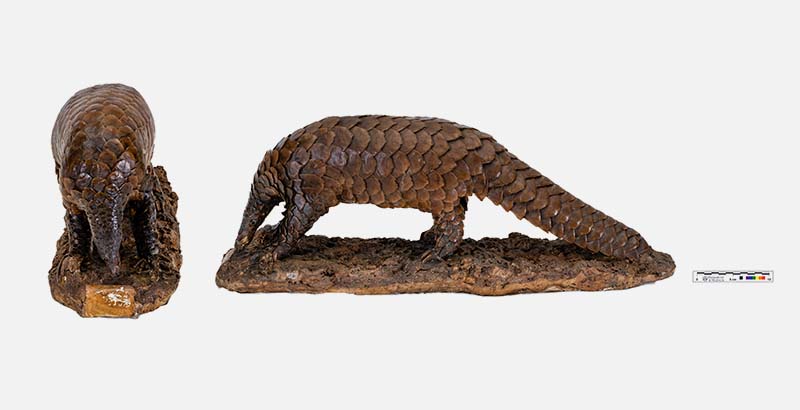Example of a giant pangolin (Manis gigantea) from the collection of the Museum of Natural Sciences Padre Ignacio Sala S.J. Code: MUVHNZJ0403 M[UV]HN.
Pangolins are a very specialised group of mammals whose most notable characteristic is the presence of scales that cover almost the entire body. They feed exclusively on invertebrates, mainly ants and termites, to which they gain access by dismantling the nests and galleries of the colonies of these insects with their strong front legs and long claws.
They have a highly developed sense of smell and, in order to defend themselves from predators, have perfected a strategy which consists of rolling up on their bellies, forming a ball, and leaving the strongest scales on the outside, so that they act together as a form of armour.
There are eight species of pangolins in the world, distributed in the continents of Africa and Asia. They inhabit forests, savannahs and open spaces, and there are two tree species. The giant pangolin in Padre Ignacio Sala's collection (in the photo) is one of the four African species and the largest of the whole genus. It comes from the former Spanish colony of Equatorial Guinea and was collected in 1954. In addition, at the MUVHN we have another specimen belonging to the historical collection of the Universitat de València. It is an Indian pangolin (Manis crassicudata), originally from India and collected in the mid-19th century.
Pangolins have recently been sadly named as one of the potential vectors of the current COVID-19 pandemic, produced by the SARS-CoV-2 coronavirus. The origin of the virus, according to specialists, must be in an animal reservoir near the city of Wuhan, where the start of the pandemic took place. Among the species that have been studied are bats, snakes and pangolins. Regarding the latter, the most recent research comparing the genomes of the virus affecting humans with the coronaviruses found in tissues of several specimens of the Malayan pangolin (Manis javanica), point to a considerable similarity between them, which reinforces the hypothesis that this species could have transmitted this disease to humans.
These animals are used as food in some African countries and are also employed in traditional medicine in many Asian countries. It is common to see whole pangolins, or parts of them, in the various markets of these regions. This situation causes a strong demand of specimens that has generated an important illegal traffic of these species and has placed some of them in a critical danger of extinction. Although various global organizations have warned of this problem and legal measures have been established to manage it, the number of illegal seizures has been increasing and the situation of many populations of these animals is already critical. The pangolin is now the most widely trafficked mammal in the world, according to the International Union for Conservation of Nature (IUCN).


















